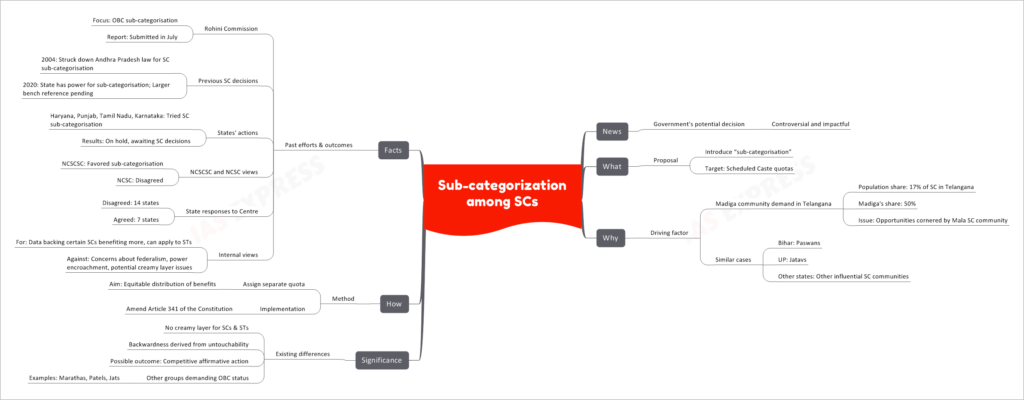Sub-categorization among Scheduled Castes

In a move that has stirred both controversy and anticipation, the government is considering a proposal to introduce “sub-categorisation” within the Scheduled Caste (SC) quotas. This potential decision carries significant implications and has garnered attention due to its far-reaching consequences.
The Proposal: Sub-Categorisation of Scheduled Caste Quotas
The government is contemplating the introduction of “sub-categorisation” within the existing Scheduled Caste quotas. This proposal aims to reorganize and distribute quotas within the SC community to ensure equitable distribution of benefits.
Driving Factors: Demands from the Madiga Community in Telangana
The primary driving factor behind this proposal is the demand from the Madiga community in Telangana. The Madiga community represents 17% of the SC population in Telangana, but they argue that opportunities have been disproportionately cornered by the Mala SC community. The Madigas assert that sub-categorisation is necessary to address this inequality.
Similar cases of demand for sub-categorisation have arisen in other states as well, such as the Paswans in Bihar and the Jatavs in Uttar Pradesh. These influential SC communities believe that sub-categorisation will enable fairer allocation of benefits and opportunities.
Significance: Addressing Existing Differences and Competitive Affirmative Action
Existing differences in the SC category, including the absence of a creamy layer concept and the persistence of backwardness stemming from untouchability, underscore the need for sub-categorisation. The possible outcome of this move is competitive affirmative action, where different sub-groups within the SC category vie for their share of quotas and benefits.
Furthermore, other groups, such as the Marathas, Patels, and Jats, have been demanding Other Backward Class (OBC) status, adding another layer of complexity to the reservation system.
Implementation: Assigning Separate Quotas and Amending the Constitution
The proposed method for sub-categorisation involves assigning separate quotas for different sub-groups within the SC category. To implement this, amendments to Article 341 of the Constitution would be required.
Historical Context and Past Efforts
The Rohini Commission
The Rohini Commission previously focused on OBC sub-categorisation and submitted its report in July. However, this report does not directly address SC sub-categorisation.
Previous Supreme Court Decisions
In 2004, the Supreme Court struck down an Andhra Pradesh law related to SC sub-categorisation. In 2020, the court asserted that states have the power to implement sub-categorisation, with a larger bench reference pending.
States’ Actions and Varying Opinions
States like Haryana, Punjab, Tamil Nadu, and Karnataka have attempted SC sub-categorisation, but the results are currently on hold, awaiting decisions from the Supreme Court.
Both the National Commission for Scheduled Castes (NCSCSC) and the National Commission for Scheduled Castes (NCSC) have varying views on sub-categorisation. The NCSCSC favors sub-categorisation, while the NCSC disagrees.
State responses to the Centre have also been divided, with 14 states disagreeing and 7 states agreeing with the proposal.
Internal Views and Concerns
Internally, the debate revolves around data backing certain SC communities benefiting more from sub-categorisation, with some in favor. Conversely, there are concerns about federalism, potential encroachment on state power, and the possibility of creating a creamy layer within the SC category.
If you like this post, please share your feedback in the comments section below so that we will upload more posts like this.

